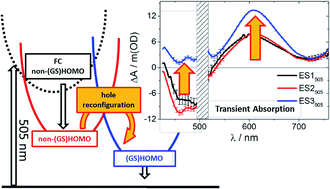当前位置:
X-MOL 学术
›
Chem. Sci.
›
论文详情
Our official English website, www.x-mol.net, welcomes your
feedback! (Note: you will need to create a separate account there.)
Trapping intermediate MLCT states in low-symmetry {Ru(bpy)} complexes
Chemical Science ( IF 7.6 ) Pub Date : 2017-08-29 00:00:00 , DOI: 10.1039/c7sc02670f Alejandro Cadranel 1, 2, 3, 4, 5 , Paola S. Oviedo 6, 7, 8, 9, 10 , German E. Pieslinger 6, 7, 8, 9, 10 , Shiori Yamazaki 11, 12, 13, 14 , Valeria D. Kleiman 11, 12, 13, 14 , Luis M. Baraldo 6, 7, 8, 9, 10 , Dirk M. Guldi 1, 2, 3, 4, 5
Chemical Science ( IF 7.6 ) Pub Date : 2017-08-29 00:00:00 , DOI: 10.1039/c7sc02670f Alejandro Cadranel 1, 2, 3, 4, 5 , Paola S. Oviedo 6, 7, 8, 9, 10 , German E. Pieslinger 6, 7, 8, 9, 10 , Shiori Yamazaki 11, 12, 13, 14 , Valeria D. Kleiman 11, 12, 13, 14 , Luis M. Baraldo 6, 7, 8, 9, 10 , Dirk M. Guldi 1, 2, 3, 4, 5
Affiliation

|
The picosecond excited state dynamics of [Ru(tpm)(bpy)(NCS)]+ (RubNCS+) and [Ru(tpm)(bpy)(CN)]+ (RubCN+) (tpm = tris(1-pyrazolyl)methane, bpy = 2,2′-bipyridine) have been analyzed by means of transient absorption measurements and spectroelectrochemistry. Emissive 3MLCTs with (GS)HOMO(h+)–(GS)LUMO(e−) configurations are the lowest triplet excited states regardless of whether 387 or 505 nm photoexcitation is used. 387 nm photoexcitation yields, after a few picoseconds, the emissive 3MLCTs. In contrast, 505 nm photoexcitation populates an intermediate excited state that we assign as a 3MLCT state, in which the hole sits in a metal-centered orbital of different symmetry, prior to its conversion to the emissive 3MLCTs. The disparities in terms of electronic configuration between the intermediate and the emissive 3MLCTs have two important consequences. On one hand, both states feature very different fingerprint absorptions in transient absorption measurements. On the other hand, the reconfiguration is impeded by a kinetic barrier. As such, the conversion is followed spectroscopically and kinetically on the 300 ps timescale.
中文翻译:

在低对称{Ru(bpy)}络合物中捕获中间MLCT状态
[Ru(tpm)(bpy)(NCS)] +(RubNCS +)和[Ru(tpm)(bpy)(CN)] +(RubCN +)的皮秒激发态动力学(tpm = tris(1- pyrazolyl)甲烷,bpy = 2,2'-联吡啶)已通过瞬态吸收测量和光谱电化学方法进行了分析。发射3 MLCTs与(GS)HOMO(H +) - (GS)LUMO(E - )配置的最低三重态激发态而不管387或505纳米的光激发是否被使用。几微微秒后,387 nm的光激发产生了发射的3个MLCT。相比之下,505 nm光激发填充了我们指定为3的中间激发态MLCT状态,其中孔位于转换为发射3个MLCT之前位于不同对称性的金属中心轨道中。中间3个和发射3个MLCT之间在电子配置方面的差异有两个重要结果。一方面,两种状态在瞬态吸收测量中均具有非常不同的指纹吸收。另一方面,动力学障碍阻碍了重构。这样,在300 ps时标上以光谱和动力学方式跟踪转换。
更新日期:2017-09-20
中文翻译:

在低对称{Ru(bpy)}络合物中捕获中间MLCT状态
[Ru(tpm)(bpy)(NCS)] +(RubNCS +)和[Ru(tpm)(bpy)(CN)] +(RubCN +)的皮秒激发态动力学(tpm = tris(1- pyrazolyl)甲烷,bpy = 2,2'-联吡啶)已通过瞬态吸收测量和光谱电化学方法进行了分析。发射3 MLCTs与(GS)HOMO(H +) - (GS)LUMO(E - )配置的最低三重态激发态而不管387或505纳米的光激发是否被使用。几微微秒后,387 nm的光激发产生了发射的3个MLCT。相比之下,505 nm光激发填充了我们指定为3的中间激发态MLCT状态,其中孔位于转换为发射3个MLCT之前位于不同对称性的金属中心轨道中。中间3个和发射3个MLCT之间在电子配置方面的差异有两个重要结果。一方面,两种状态在瞬态吸收测量中均具有非常不同的指纹吸收。另一方面,动力学障碍阻碍了重构。这样,在300 ps时标上以光谱和动力学方式跟踪转换。











































 京公网安备 11010802027423号
京公网安备 11010802027423号